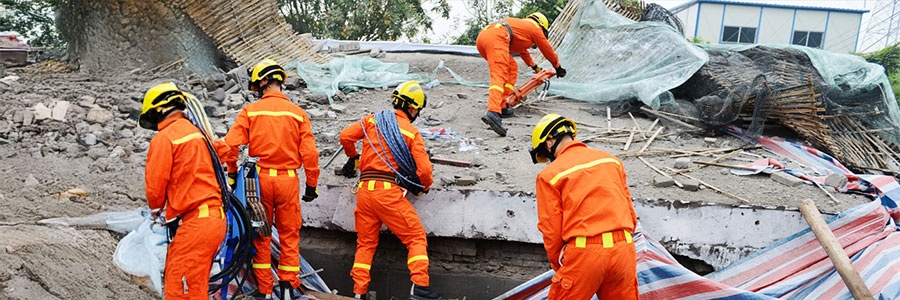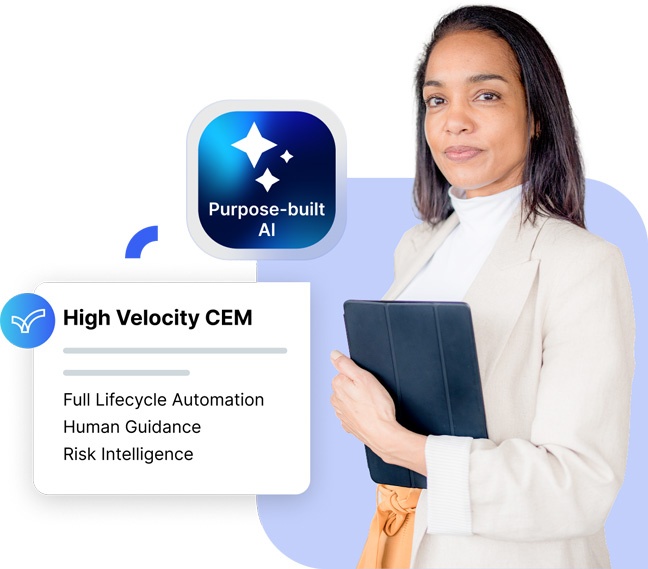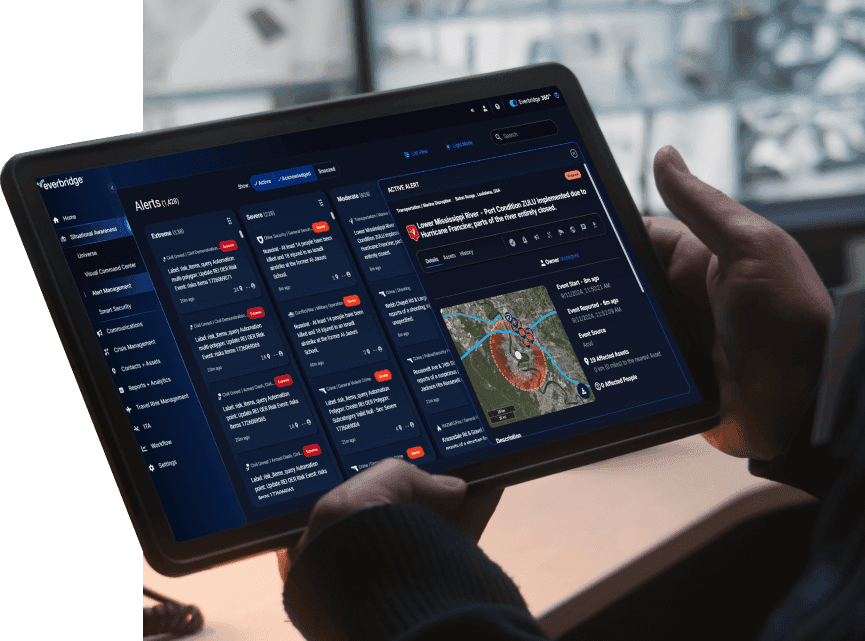
Top 10 questions to ask when Choosing the right business continuity platform
In today’s environment of heightened risk, operational complexity, and regulatory scrutiny, selecting the right business continuity platform is more than a technical decision—it’s a strategic imperative. Whether you’re a Business Continuity Manager ensuring plan effectiveness, a Risk Officer safeguarding compliance, or an IT Disaster Recovery (DR) leader striving for uninterrupted service delivery, your organization’s resilience depends on having the right tools in place.
Everbridge delivers a business resilience advantage with High Velocity CEM™, protecting organizations from the impact of critical events. By combining market-leading innovation, decision-ready risk intelligence, and full lifecycle automation, Everbridge ensures that managing critical events is as easy as 1-2-3. Only Everbridge helps organizations know earlier, respond faster, and improve continuously.
Selecting the right business continuity platform is a significant decision with long-term implications. It’s therefore essential to ask the right questions to ensure that the chosen solution aligns with your organization’s unique needs. To simplify your due diligence process, we’ve compiled the top 10 questions to ask potential business continuity vendors, along with valuable insights to guide your evaluation.
1. How does the platform centralize data and processes?
A strong platform should consolidate all business continuity, disaster recovery, and risk data into a single system. Centralization ensures consistency by using key data sources, reduces silos, improves visibility, and streamlines decision-making during disruptions.
What to ask:
- What type of templates are provided out of the box to get me started?
- Can the platform integrate data from existing tools like HR, facilities management, IT CMDB, risk management, and incident management solutions?
- Are there standardized import templates to manage my data?
- Does the platform provide an enterprise impact map with a unified view of dependencies and risks in my organization?
- Can I visually see upstream and downstream dependencies to understand single points of failure and critical assets?
- Can the data be segmented between business and IT DR?
- Does the platform provide standard summary reports and dashboards to see the health and status of my program and gaps to be addressed?
2. How configurable and adaptable is the platform?
The platform should be flexible enough to meet your organization’s unique needs while allowing for future growth and changes.
What to ask:
- Can I add new data tables and fields to match my organizational data?
- Are templates, calculations, and reports modifiable?
- How easily can I create new assessment templates, plan templates, and reports?
- Can I enhance a template and retain historical information and responses?
- Do I need technical expertise to apply changes to my templates, calculations, and reports? Does this require engagement with the vendor or a third party?
- Will I still receive upgrades and enhancements if I made configuration changes or modified templates?
3. Does the platform support regulatory compliance?
Compliance is a critical component of business continuity and disaster recovery. The platform should help you meet standards like ISO 22301, FFIEC, FCA, DORA, and SOC 2 while simplifying audit preparation.
What to ask:
- Does the platform provide audit logging of Business Continuity (BC)/DR activities?
- Will I receive updated templates and reports that align with regulatory requirements?
- Is there an automated workflow to alert users when information requires attention or updating?
- Can I easily generate compliance reports to provide to auditors and examiners?

4. What pre-built resources and templates does the platform offer?
Look for platforms that provide ready-to-use templates and workflows aligned with industry standards to save time and ensure consistency.
What to ask:
- Are the templates aligned with industry standards and best practices?
- Do they cover key areas like impact assessments, planning, testing, risk management, and reporting?
- Can templates be easily configured without technical expertise?
- Can I easily modify dropdown options to align with my terminology and resource types?
5. Dependencies
Understanding dependencies is key to effective recovery planning. The platform should visualize upstream and downstream dependencies and identify single points of failure.
What to ask:
- Can I configure the dependency view to see what matters to me?
- Are orphaned records and critical dependencies easily viewable?
- Does the platform provide tools to assess the impact of failures across the organization?
- Can I filter and see key asset dependencies at multiple levels?
- Are dependencies considered when testing my plans?
- Can I see where there are gaps in my response and recovery times for key dependencies such as applications and suppliers?
6. What type of reporting is available in the platform?
All tasks are not the same and should be dynamic based on the response phases and plan type they are associated with.
What to ask:
- Does the platform provide out-of-the-box reports for Business Impact Analysis, Plans, Risks, and Testing?
- Can I create new reports?
- Can reports be automatically sent to stakeholders without manual intervention?
- Are gaps for recovery time objectives (RTOs) easily identified (i.e. application recovery, supply chain, exercises)?
- Are summary reports available to roll data up to location, business entity, or executive leader/stakeholder?
- Can non-licensed users access copies of plans?
- Does the platform provide standard summary reports and dashboards to see the health and status of my program and gaps to be addressed?
7. What automation capabilities does the platform offer?
Automation reduces manual effort and ensures consistency. The platform should support automated workflows for creating, updating, and approving plans, as well as testing and tracking results.
What to ask:
- Can the platform automate alerts, testing, and reporting?
- Does it include automated workflows for cross-departmental collaboration?
- Can workflows be modified based on my organizational settings and frequency for updates?
- Can the platform escalate delinquent activities to leadership for higher levels of visibility and accountability?

8. How does the platform support program visibility?
Dashboards and analytics are essential for tracking program health and readiness. The platform should provide real-time insights and executive-level reporting.
What to ask:
- Can it generate reports that communicate ROI and resilience metrics to stakeholders?
- Does it offer dashboards to visualize program health and readiness?
- Can I create or modify my own reports or do I need to engage with the vendor?
- Can I track the progress of recovery when conducting an exercise/test?
9. Does the planning platform provide integration with critical event management?
Integrating planning with critical event management is essential because it bridges the gap between proactive preparedness and real-time response. Together, they create a seamless, end-to-end approach for managing disruptions, ensuring the plan information is accessible, visible, and leveraged for response activities.
What to ask:
- Does the platform provide automated integration between planning and critical event management for free?
- What information is available from my BIA (Business Impact Analysis) and plan to help make informed decisions regarding impact?
- Can I see the dependencies and resources required for recovery?
- Can I activate plan response strategies and track recovery tasks being completed?
- Does my executive team understand why incidents were invoked and see incident trends over time?
- Does the platform show my team which services to restore and in what order during an incident?
10. What training and support are available?
Even the most intuitive platform requires training and support. The vendor should offer resources to ensure smooth onboarding and long-term success.
What to ask:
- What onboarding and training options are included?
- Is ongoing support available to address future needs and challenges?
- Is support a paid service or included in the subscription?
- Do I need to engage with a third-party vendor for support or changes to myprogram and what is the cost?
- Are there self-service training sessions available if I want to expand my use of theplatform?
- Do I need a license for test participants and infrequent users such as plan or BIAapprovers?
- How long is a typical implementation?
Making a well-informed decision
Choosing the right business continuity platform isn’t just about features; it’s about finding a reliable partner. By asking these 10 questions, you’ll be equipped to identify the best solution for your organization’s needs, ensuring resilience and operational continuity for years to come.





